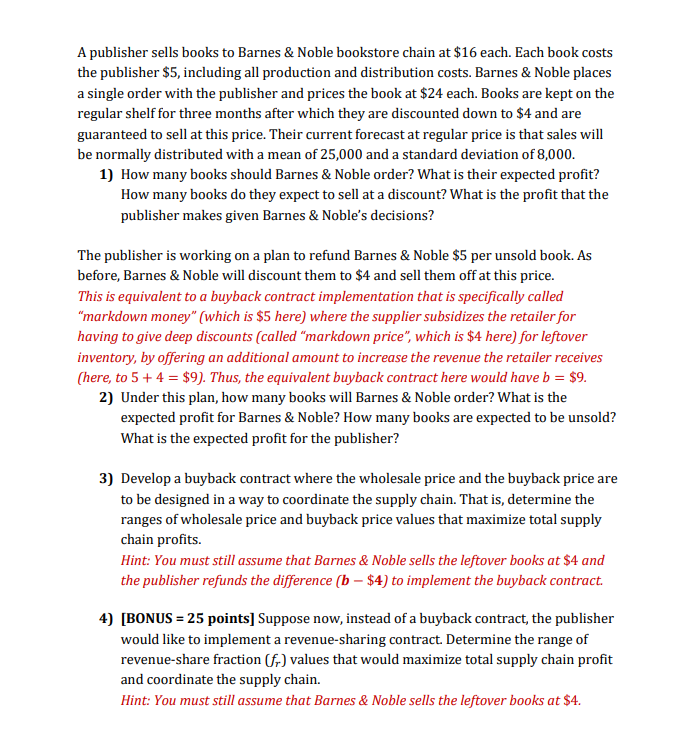Only question number 3, please!
A publisher sells books to Barnes & Noble bookstore chain at $16 each. Each book costs the publisher $5, including all production and distribution costs. Barnes & Noble places a single order with the publisher and prices the book at $24 each. Books are kept on the regular shelf for three months after which they are discounted down to $4 and are guaranteed to sell at this price. Their current forecast at regular price is that sales will be normally distributed with a mean of 25,000 and a standard deviation of 8,000. 1) How many books should Barnes & Noble order? What is their expected profit? How many books do they expect to sell at a discount? What is the profit that the publisher makes given Barnes & Noble's decisions? The publisher is working on a plan to refund Barnes & Noble $5 per unsold book. As before, Barnes & Noble will discount them to $4 and sell them off at this price. This is equivalent to a buyback contract implementation that is specifically called "markdown money" (which is $5 here) where the supplier subsidizes the retailer for having to give deep discounts (called "markdown price", which is $4 here) for leftover inventory, by offering an additional amount to increase the revenue the retailer receives (here, to 5 + 4 = $9). Thus, the equivalent buyback contract here would have b = $9. 2) Under this plan, how many books will Barnes & Noble order? What is the expected profit for Barnes & Noble? How many books are expected to be unsold? What is the expected profit for the publisher? 3) Develop a buyback contract where the wholesale price and the buyback price are to be designed in a way to coordinate the supply chain. That is, determine the ranges of wholesale price and buyback price values that maximize total supply chain profits. Hint: You must still assume that Barnes & Noble sells the leftover books at $4 and the publisher refunds the difference (b $4) to implement the buyback contract. 4) [BONUS = 25 points] Suppose now, instead of a buyback contract, the publisher would like to implement a revenue-sharing contract. Determine the range of revenue-share fraction (fr) values that would maximize total supply chain profit and coordinate the supply chain. Hint: You must still assume that Barnes & Noble sells the leftover books at $4. A publisher sells books to Barnes & Noble bookstore chain at $16 each. Each book costs the publisher $5, including all production and distribution costs. Barnes & Noble places a single order with the publisher and prices the book at $24 each. Books are kept on the regular shelf for three months after which they are discounted down to $4 and are guaranteed to sell at this price. Their current forecast at regular price is that sales will be normally distributed with a mean of 25,000 and a standard deviation of 8,000. 1) How many books should Barnes & Noble order? What is their expected profit? How many books do they expect to sell at a discount? What is the profit that the publisher makes given Barnes & Noble's decisions? The publisher is working on a plan to refund Barnes & Noble $5 per unsold book. As before, Barnes & Noble will discount them to $4 and sell them off at this price. This is equivalent to a buyback contract implementation that is specifically called "markdown money" (which is $5 here) where the supplier subsidizes the retailer for having to give deep discounts (called "markdown price", which is $4 here) for leftover inventory, by offering an additional amount to increase the revenue the retailer receives (here, to 5 + 4 = $9). Thus, the equivalent buyback contract here would have b = $9. 2) Under this plan, how many books will Barnes & Noble order? What is the expected profit for Barnes & Noble? How many books are expected to be unsold? What is the expected profit for the publisher? 3) Develop a buyback contract where the wholesale price and the buyback price are to be designed in a way to coordinate the supply chain. That is, determine the ranges of wholesale price and buyback price values that maximize total supply chain profits. Hint: You must still assume that Barnes & Noble sells the leftover books at $4 and the publisher refunds the difference (b $4) to implement the buyback contract. 4) [BONUS = 25 points] Suppose now, instead of a buyback contract, the publisher would like to implement a revenue-sharing contract. Determine the range of revenue-share fraction (fr) values that would maximize total supply chain profit and coordinate the supply chain. Hint: You must still assume that Barnes & Noble sells the leftover books at $4







